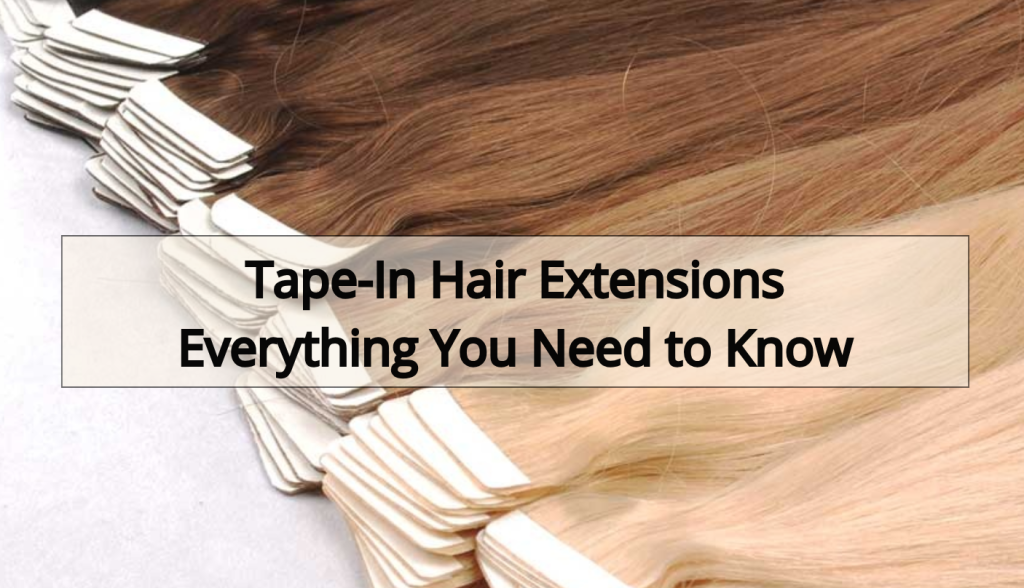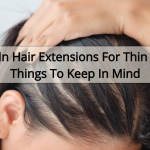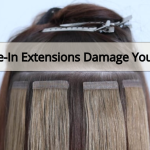Hair Knowledge
Tape-In Hair Extensions: Everything You Need to Know
I. What Are Tape-In Hair Extensions?
1.1 What Are Tape-In Hair Extensions?
Tape-in hair extensions are a semi-permanent method of adding length and volume to natural hair. They are applied using ultra-thin, transparent adhesive strips known as tape tabs. Each weft is approximately 4 cm wide and is installed in pairs—one on top and one underneath a small section of natural hair—creating a “sandwich” structure. This technique requires minimal heat, causes little to no damage, and is ideal for clients who want a fuller, longer hairstyle without compromising hair health.
1.2 Structure of Tape-In Hair Extensions
Despite their simple appearance, tape-in extensions are designed with precise technical components to ensure durability, comfort, and a seamless finish. Each weft is made up of three main parts:
1.2.1 Human Hair Strands
- Material: Most tape-ins are made from 100% real human hair—commonly Remy or Virgin Hair. These types maintain aligned cuticles, which preserves the softness, strength, and natural shine of the strands.
- Fullness from root to tip: Higher-end options use double drawn or super double drawn hair to ensure the bundle is thick and even throughout its length.
- Color and texture: Available in natural tones or custom-colored to match the client’s needs. Popular textures include straight, body wave, loose wave, and deep wave.
1.2.2 Adhesive Tabs (Tape Tabs)
- Material: Crafted from soft, thin polyurethane (PU), the tape is designed to be nearly invisible once installed, blending smoothly under the client’s natural hair.
- Hold strength: Uses high-quality adhesive that offers strong hold without damaging the scalp or natural hair. You can replace the tape to reuse up to 2-3 times for each set of tape-in extensions
- Size: Each tape tab is around 4 cm wide and very lightweight, making it suitable even for sensitive areas such as the hairline or temples.
1.2.3 Weft Design
- Flat and flexible: The tape is designed as a flat weft that sits closely against the scalp. It doesn’t cause bulk or bumps, ensuring comfort and a discreet appearance.
- Easy to customize: You can trim and shape the wefts to fit different areas of the head, especially near the crown, to achieve a seamless and natural blend.
1.3 Key Advantages of Tape-In Hair Extensions
Tape-in extensions are not only popular because of how convenient they are, but also because of the many technical benefits they offer:
- Natural and Nearly Invisible: Thanks to their ultra-flat design and clear adhesive tabs, tape-ins blend seamlessly with the client’s natural hair. The attachment points are virtually undetectable—even when the hair is tied up in a ponytail or bun.
- Lightweight and Ideal for Fine Hair: Unlike clip-ins or sew-ins, tape-in extensions distribute weight evenly across a wide section of natural hair. This minimizes tension on the scalp, making them a great choice for clients with fine, fragile, or recovering hair.
- Quick Application Time: A skilled stylist can apply a full head of tape-ins in just 45 to 60 minutes—significantly faster than fusion or sew-in methods. It’s a time-efficient option for both salons and clients.
- Reusable and Cost-Efficient: Tape-in extensions can be reused multiple times. After 6–8 weeks, you can remove, clean and re-apply new adhesive -offering long-term value and helping reduce waste.
- Versatile Styling Options: Whether your client wants to add volume, length, or even create highlights or lowlights without using chemicals, tape-ins can deliver the look with minimal effort.
II. Types of Tape-In Hair Extensions
Tape-in extensions can vary not only in hair quality, but also in technical design—such as the type of adhesive tape used, the weft structure, and the specific purpose of application. Below are the most common types available on the market today:
2.1. Regular Tape-In Hair Extensions
2.1.1. What Are They?
Regular tape-in hair extensions are the most widely used and classic version of tape-ins. Each weft comes pre-attached with a thin strip of adhesive tape, typically 3.5 to 4 cm wide. During installation, a thin section of natural hair is placed between two tape-in wefts—one on top and one underneath—forming a “sandwich” structure.
2.1.2. Structure & Technical Features
- Tape: High-quality medical-grade acrylic adhesive that holds firmly but can be removed easily using professional remover solutions. The adhesive strip is attached directly to the root area of the hair weft.
- Hair: Available in Remy, Virgin, or Double Drawn options depending on the client’s needs. Remy hair is the most popular choice for tape-ins due to its durability and natural appearance.
- Weight: Each tape piece weighs around 2.5–3 grams. A full set usually includes 20–40 pieces (10–20 sandwiches), depending on whether it’s used for a full head installation or partial volume enhancement.
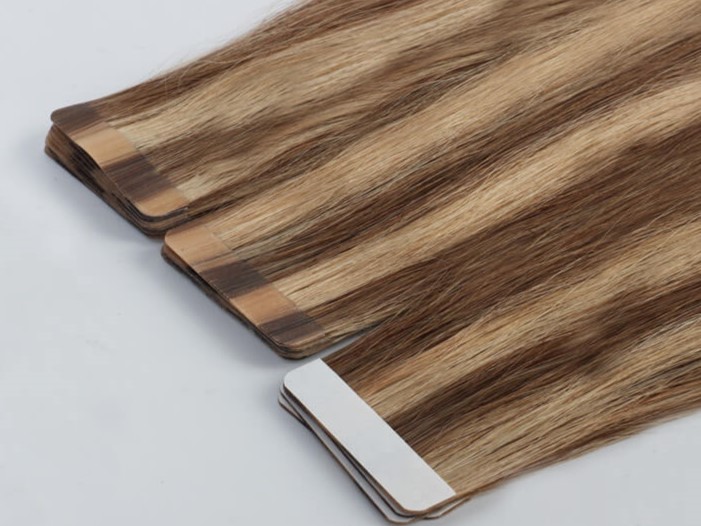
2.1.3. Best Use Cases & Ideal Clients
Regular tape-ins are versatile and suitable for a wide range of clients—from first-time users to professional salon customers. Their easy application and removal make them ideal for:
- Clients who want a quick volume boost
- Temporary transformations for events, weddings, or photo shoots
Individuals with fragile hair that cannot tolerate heat-based or pressure-based methods like micro rings or keratin bonds
2.2. Seamless Tape-In Hair Extensions
2.2.1. What Are They?
Seamless Tape-In extensions are an upgraded version of traditional tape-ins, designed for a lighter, more comfortable, and natural-looking wear. As the name suggests, “seamless” means there are no visible edges—the tape blends smoothly with the natural hair without any bumps or harsh lines.
These extensions are ultra-thin, soft, and flexible. When viewed from above, the attachment is almost invisible to the naked eye.
2.2.2. Structure & Technical Features
Construction: Seamless tape-ins are made with a special polyurethane adhesive base. Some designs are heat-sealed or finished with a soft coating (often silicone or film) to ensure the tape lies flush against the scalp. Certain types also feature a “half-covered” backing for added hold while still allowing breathability.
Key Highlights:
-
Ultra-thin and lightweight: Minimizes pressure on the natural hair and scalp—ideal for sensitive clients.
-
High aesthetic appeal: Smooth, discreet, and easily concealed by natural hair for a “growing from the scalp” effect.
-
Easy application and removal: Quick to install and remove, making them suitable for both salon professionals and experienced at-home users.
-
Reusable: Typically reusable 2–3 times by replacing the tape, depending on maintenance and removal technique.
-
Wear time: Each installation can last 6–8 weeks before needing reapplication.
Usage Notes:
Avoid using oils, silicone-based serums, or sulfate-containing shampoos near the tape area, as they may reduce adhesion. Always blow-dry the roots thoroughly after washing to maintain a strong bond.
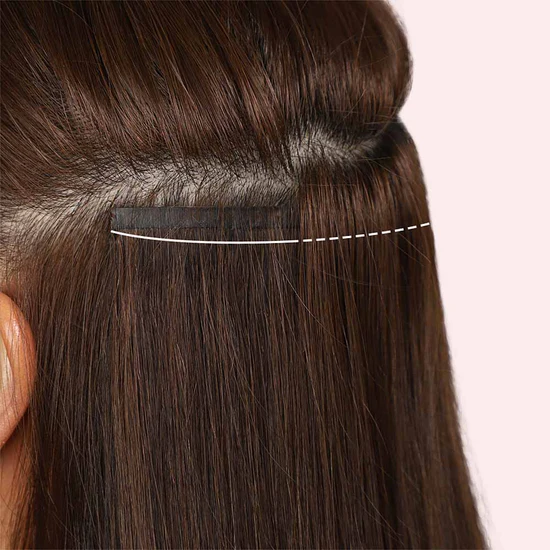
2.2.3. Best Use Cases & Ideal Clients
-
Clients with fine to medium hair who want a natural, seamless appearance
-
Individuals with sensitive scalps who may find regular tape-ins too bulky or irritating
-
Long-term extension users who prioritize daily comfort and aesthetic perfection in everyday styling
2.3. Invisible Tape-In Hair Extensions
2.3.1. What Are They?
Invisible tape-in hair extensions are the most advanced and natural-looking version of the tape-in category. What makes them different is the thin veil of real hair that covers the top surface of each tape tab, creating the illusion that the hair is growing directly from the scalp. This gives a flawless, undetectable result even when viewed up close.
These extensions are ideal for clients with very fine hair or those who part their hair in visible areas, thanks to their ability to remain completely hidden.
2.3.2. Structure & Technical Features
Construction:
Invisible tape-ins are built similarly to regular tape-ins (two hair wefts attached with medical-grade tape), but the upper tape surface is covered with a fine layer of human hair. This layer is carefully sealed or heat-pressed onto the tape, concealing the adhesive completely.
Key Highlights:
- Truly invisible finish: The top hair covering hides the tape entirely, blending seamlessly into the client’s natural hair—even under close inspection.
- Lightweight and flexible: Comfortable to wear, gentle on the scalp, and perfect for daily use.
- High aesthetic appeal: Especially suitable for middle parts, hairlines, and half-up hairstyles.
- Premium quality: Typically made from high-grade Virgin or Remy hair, processed with extra care.
- Reusable: Can be removed, cleaned, and reapplied with new tape multiple times if maintained properly.
Usage Notes:
- The hair veil on the tape is delicate, so removal and reinstallation must be done gently to avoid tearing or tangling.
- Typically comes at a higher price point due to the added craftsmanship.
- Avoid applying oil-based products or silicone near the root area, as this may weaken the adhesive.
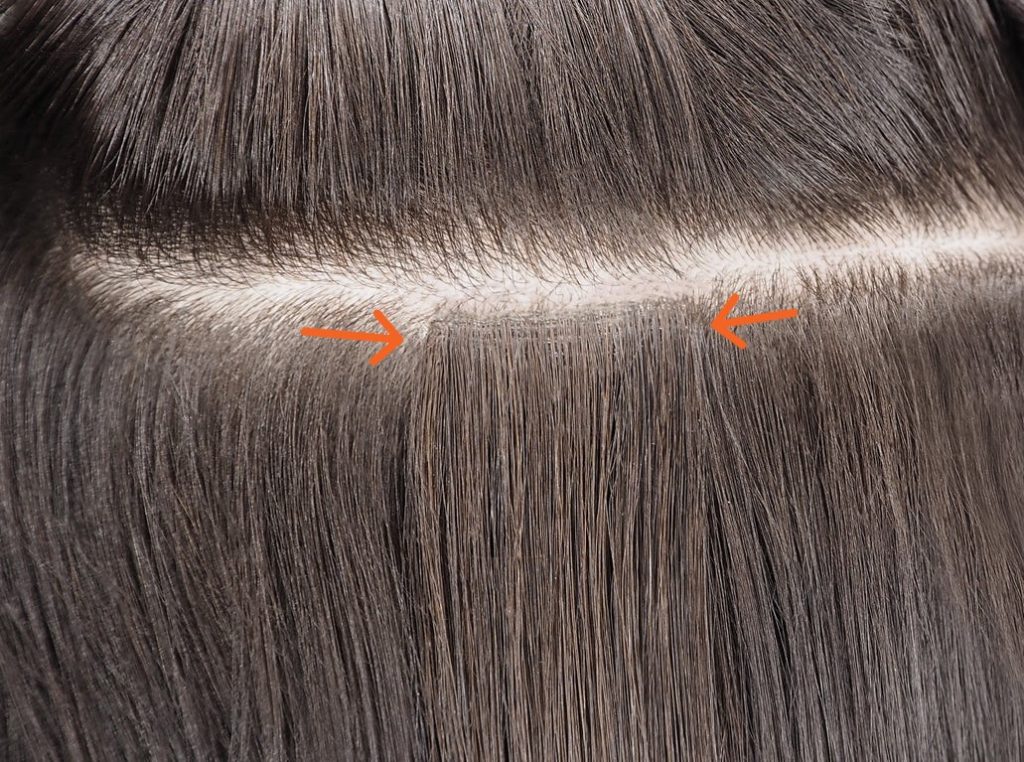
2.3.3. Who Are They Best For?
- Women with very fine or sparse hair, especially those concerned about visible attachment points.
- Clients with high aesthetic expectations who want a truly invisible extension method.
- Perfect for special events, photoshoots, and HD video work where detail matters.
- Suitable for both professional stylists and confident at-home users with some technical skill.
🔍 Comparison: Invisible vs. Seamless Tape-In Hair Extensions
| Criteria | Invisible Tape-In | Seamless Tape-In |
| Definition | Tape extensions with a thin layer of hair covering the top to fully hide the adhesive | Tape extensions with a PU (polyurethane) strip in a skin-like or transparent finish |
| Structure | – 2 wefts + medical-grade tape
– Top surface covered with a fine hair layer |
– 2 wefts + soft PU strip
– No hair covering the top |
| Natural Appearance | ⭐⭐⭐⭐⭐ Extremely natural – invisible even when parting the hair | ⭐⭐⭐⭐ Very natural – blends well but may show in close-up parting |
| Thickness at Attachment | Ultra-thin and soft | Slightly thicker due to PU base |
| Suitability for Fine Hair | Excellent – perfect for clients with very thin or sparse hair | Good – best placed in middle/lower areas of the head |
| Durability | 6–8 weeks per install; reusable 3–5 times | 6–8 weeks per install; reusable 2–3 times |
| Styling Flexibility | Highly flexible – suitable for high ponytails and exposed styles | Moderately flexible – requires careful styling for updos |
| Cost | Higher – due to intricate craftsmanship and hair-covered design | Mid-range – easier to produce and apply |
| Best For | Clients who want maximum invisibility and top-tier aesthetics | Clients seeking natural-looking results at a more affordable price |
III. Production Process & Technical Structure of Tape-In Hair Extensions
Creating high-quality tape-in extensions requires a blend of precise craftsmanship and semi-automated machinery. The process involves multiple steps to ensure each product is consistent, durable, and ready for professional salon use.
3.1 Hair Selection & Pre-Treatment
- Raw materials: Virgin or Remy hair with intact cuticles, ethically sourced and cleaned using chemical-free methods to preserve strand integrity.
- Sorting: Sort hair carefully by length, thickness, and color tone to ensure uniformity across batches.
Texturizing: Hair may be steam-straightened or waved depending on the desired texture (e.g. straight, body wave, deep wave, curly).
3.2 Tape Base Preparation
- The tape base is typically made from polyurethane (PU)—a thin, heat-resistant, skin-safe material with strong bonding properties.
- PU strips are cut precisely by laser or by hand, usually into sizes like 4 cm x 0.8 cm or 4 cm x 1 cm, depending on the tape type.
3.3 Attaching Hair to the PU Base
- Skilled workers hand-place hair strands evenly across the PU tape strip based on the desired density level: standard, thick, or super double drawn.
- A special hot-melt glue or medical-grade adhesive is then used to securely bond the hair to the base.
3.4 Applying the Tape Adhesive
- After bonding, a double-sided medical adhesive tape is applied to the PU strip.
- Depending on the order, the factory uses different types: regular tape, invisible tape, or pre-taped variants.
- A protective film layer is added on top of the adhesive to preserve stickiness until installation.
3.5 Final Quality Control
Each batch of tape-in hair extensions undergoes a strict quality check to verify:
- Adhesion strength
- Consistency of hair density and length
- Color accuracy and texture match
Only products that meet export standards are packed and shipped to clients worldwide.
IV. How to Apply & Maintain Tape-In Hair Extensions
Tape-in extensions are one of the most salon-friendly and client-preferred methods for enhancing length and volume. They are easy to apply, lightweight, reusable, and comfortable for long-term wear. However, their longevity and appearance depend greatly on proper installation and aftercare.
4.1. Professional Application in the Salon
Tape-ins application should always be done by a trained stylist to ensure a secure hold and to avoid damaging the client’s natural hair.
4.1.1 Sandwich Technique
- Each section of natural hair is placed between two tape-in wefts, forming a “sandwich.”
- The natural hair layer must be thin and even to ensure optimal adhesion.
- The tapes should be applied approximately 0.5–1 cm away from the scalp to allow natural movement.
4.1.2 Tape Direction
- Tapes must be aligned parallel to the scalp, not angled or tilted.
- The direction of extension placement must follow the natural hair growth pattern to avoid tension and tangling.
4.1.3 Required Tools
- Professional sectioning comb
- Flat pliers (optional for reinforcement)
- Sectioning clips
- Flat iron or hot press (if using heat-based adhesive)
4.1.4 Key Tips During Installation
- Do not wash hair for 24–48 hours after application to allow adhesive to cure fully.
- Avoid oils or silicone-based products near the roots.
- Average wear time per application: 6–8 weeks, after which reapplication is required.
4.2. Daily Care & Maintenance
4.2.1 Washing
- Wash hair with lukewarm water; avoid directing water pressure onto the tapes.
- Use sulfate-free and silicone-free shampoos to prevent tape slippage.
- Gently massage downward—never scrub or scratch near the tape area.
4.2.2 Conditioning
- Apply conditioner only from mid-length to ends.
- Leave-in conditioners are allowed, but must be sprayed at least 3–5 cm away from the tape bonds.
4.2.3 Drying & Heat Styling
- Pat hair dry with a soft towel—do not wring.
- Blow-dry on a medium heat setting, and avoid applying heat directly to the adhesive tabs.
- If using heat tools, keep temperature under 180°C.
4.3. Storage & Reuse
4.3.1 Wear Cycle
- Tape-ins can be reused 3–4 times if properly removed, cleaned, and maintained.
- Each wear cycle typically lasts 6–8 weeks, depending on hair growth and care habits.
4.3.2 Removal & Cleaning
- Use a professional tape remover (alcohol- or oil-based) to loosen the adhesive.
- Gently peel apart the tape sandwiches—never pull.
- Remove any adhesive residue, allow the wefts to fully dry, then apply new tape strips.
4.3.3 Storage When Not in Use
- Store in a mesh pouch, plastic case, or zip bag to prevent tangling and dust.
- Keep in a cool, dry place, away from direct sunlight and humidity.
V. Who Are Tape-In Hair Extensions Best For?
Tape-in extensions are high versatility, but they’re not a one-size-fits-all solution. Understanding the ideal hair types and use cases helps ensure the best possible results.
5.1. Best Suited For:
✔️ Clients with fine to medium hair
Tape-ins are ideal for those with thin or moderately thick hair. Their flat, lightweight design allows for even weight distribution across the scalp, minimizing tension and making them safe for fragile strands.
✔️ Anyone looking for quick volume or length
Tape-ins can transform a client’s look in under two hours—without the need for heat, glue, or chemicals. The result is instant length and thickness that blends naturally with the real hair.
✔️ Busy professionals or low-maintenance users
Once applied, tape-ins stay in place and can be styled, washed, and worn daily without removal. This makes them a great choice for clients with demanding schedules.
5.2. Who Should Be Cautious?
⚠️ Clients with very oily scalps or severely weak hair
Excess scalp oil may interfere with tape adhesion. Also, individuals with highly damaged or shedding hair should consult a stylist before application to avoid further stress on the roots.
⚠️ Athletes or frequent swimmers
Sweat and water exposure can weaken the adhesive over time. For clients with highly active lifestyles, removable options like clip-in extensions may be more suitable.
5.3. Are Tape-In Extensions Safe for Natural Hair?
Yes—when applied and maintained properly. To ensure safety and longevity:
- Always apply with proper spacing and tension
- Use professional removers when taking them out
- Reinstall every 6–8 weeks at the salon
When handled by a trained stylist, tape-ins will not damage the natural hair. That’s why they continue to be a top choice in professional salons across Europe.
👉Do Tape-In Extensions Damage Your Hair?
Final Thoughts
Tape-in hair extensions strike the perfect balance between beauty, practicality, and client comfort—making them one of the most trusted methods in modern salons. With options like regular, invisible, and seamless designs, stylists can tailor each installation to suit different hair types, aesthetic needs, and lifestyles.
Whether you’re just beginning your salon business or seeking to upgrade your extension services, understanding the structure, application techniques, maintenance, and client suitability of tape-ins is key to long-term success.
At N Hair Factory, we commit to providing high-quality tape-in extensions made from 100% human hair, crafted to meet the standards of professional stylists across Europe. From raw material selection to custom manufacturing, we’re here to support your artistry—and your business growth.
Related Articles
How Long Do Tape In Extensions Last?
Human Hair Extensions: Everything You Need to Know

